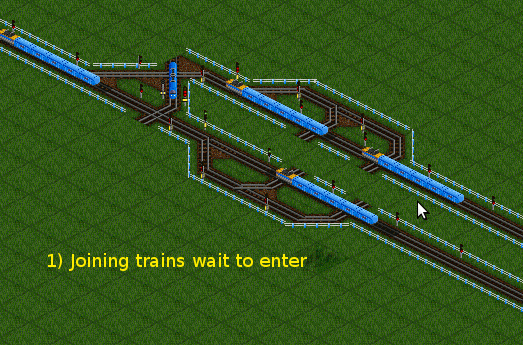Difference between revisions of "Two-way Prio"
From #openttdcoop wiki
| Line 15: | Line 15: | ||
== Benefits == | == Benefits == | ||
| − | + | * Releases entire queues in both directions at once without breaking the queue. | |
| − | + | * This usually give tight packing as the entire queue is release at once. | |
| − | + | * Adapts well to the traffic load. On light traffic, the logic train is usually blocked in the prio before a single train can reach it, leaving the path open. | |
Revision as of 20:18, 14 March 2010
A standard prio gives priority to trains on the mainline and makes trains on the sideline way. In some join, especially at BBHs, a prio may build up long queues waiting to enter the mainline.
On PSG 178, we experimented with a concept named a Two-way Prio. The basic idea is that when the waiting trains begin to roll, they should keep rolling and not stop for a few trains on the ML. The mechanism is similar to a real-life traffic light. It releases all traffic in one direction and then switches to the other direction and releases all traffic from there (although, the Two-way prio does not have a timeout, like traffic lights).
How to build
Add a small TL1 train on a segment that crosses the two lines. The TL1 train should be blocked by a standard prio in both direction by using a two-way entry signal.
A two-way prio does not need a long prio on the tracks. It just needs to be long enough that trains waiting will enter the prio before the logic train has a chance to switch.
A place to use this is in BBHs where neither of the MLs is more major than the other. A simple join will leave huge gaps, and a standard prio may build big queues even with good balancing.
Benefits
- Releases entire queues in both directions at once without breaking the queue.
- This usually give tight packing as the entire queue is release at once.
- Adapts well to the traffic load. On light traffic, the logic train is usually blocked in the prio before a single train can reach it, leaving the path open.
